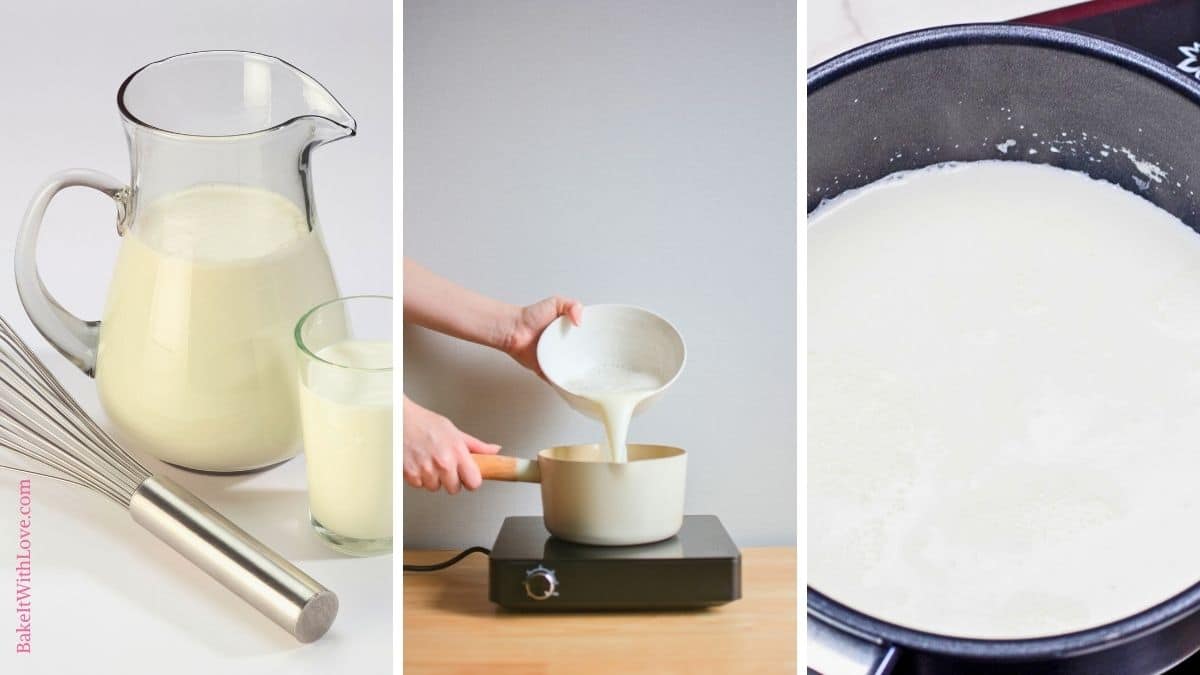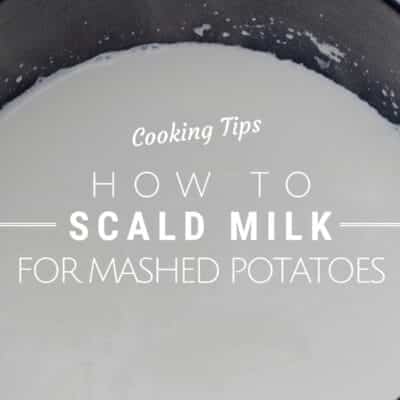Knowing how to scald milk quickly for mashed potatoes is a simple trick that can take your potatoes from ordinary to incredibly fluffy and smooth. It's an extra step I recommend for the best restaurant-quality potatoes. This guide will show you how to scald milk on the stovetop or in the microwave so your potatoes turn out perfect every time.
You can use scalded milk in any of my mashed potato recipes. See the best potatoes for mashed potatoes for tips on making potatoes from scratch.

Making mashed potatoes is a pretty straightforward process. However, one crucial trick can make the difference between basic mashed potatoes and creamy, delicately fluffy potatoes: scalded milk. Here's how to do it.
Why Scald Milk For Mashed Potatoes?
Scalding milk means heating it to just below boiling, then letting it cool slightly. This step matters because:
- Adding hot milk ensures you're not reheating the potatoes after mashing, helping maintain their smooth structure.
- Hot milk absorbs better into the potatoes, giving them a lighter, creamier texture.
- Cold milk can shock the potatoes and lead to overmixing, which causes a gluey, gummy consistency.
🥛 How To Scald Milk (2 Easy Methods)

Stovetop Method (Recommended)
Step 1: Add milk. Add 1 cup (237 milliliters) of cold milk to a heavy-bottomed skillet or wide, shallow saucepan.
Step 2: Heat and stir. Put the pan over medium heat, stirring frequently.
Step 3: Remove from heat. Once bubbles form around the sides of the pan and it reaches 180-185°F (82-85°C), remove from heat.
Microwave Method
Step 1: Get a microwave-safe container. Pour your cold milk into a large microwave-safe container.
Step 2: Cover with a wooden spoon. Place a wooden spoon across the top of the container to prevent the milk from scorching.
Step 3: Microwave the milk. On 50% power, heat the milk in 30-second increments, stirring between each interval and keeping an eye on the temperature.
>>>See All Of My Tasty Recipes Here!<<<
💭 Angela's Pro Tips & Recipe Notes
- Stir, stir, stir. Stir frequently while heating the milk to prevent scorching or sticking to the pan.
- Look for bubbles. You'll know the milk is scalded when small bubbles form around the edges of the saucepan. If it reaches a rolling boil, it's been overheated. Stop just before the boiling point.
- Be careful with baked goods. For mashed potatoes, the hot milk can be added directly. For baked goods, scalded milk usually needs to cool to around 110°F (43°C).
- Hot milk will kill yeast. Avoid using scalded milk that's too hot (above 138°F/ 59°C) when working with yeast, as it can kill the yeast and prevent rising.
- Non-dairy milk won't scald. Only dairy milk can be properly scalded. Non-dairy alternatives (like almond milk or oat milk) don't contain the same proteins and don't behave the same way when heated.
- Add extra milk to account for evaporation. Some recipes account for evaporation during scalding. If not, measure your milk after scalding to ensure the right amount or start with a little extra if needed.
Other Recipes That Use Scalded Milk
Scalded milk is a key step in many recipes, like bread, cakes, and ice cream (and skipping it can affect your results).
- In bread baking recipes, scalding milk weakens the whey proteins that can inhibit yeast growth and reduce gluten from forming, helping the dough rise faster, more reliably, and with more elasticity.
- For ice cream recipes, scalded milk absorbs flavors like vanilla, coconut, or lemon better, creating a richer, more flavorful base.
- In cake recipes, scalded milk helps melt butter and dissolve sugar smoothly, ensuring a tender, even crumb.
- It makes hot chocolate extra smooth and creamy by blending more evenly with cocoa and sugar.
Did you find these scalding milk tips helpful? Let me know in the comments, and don't forget to share how you used it in your favorite recipe!
Do you love a recipe you tried? Please leave a 5-star 🌟rating in the recipe card below and/or a review in the comments section further down the page.
Stay in touch with me through social media @ Pinterest, Facebook, Instagram, or Twitter! Subscribe to the newsletter today (no spam, I promise)! Don't forget to tag me when you try one of my recipes!
📖 Recipe Card
How to Quickly Scald Milk (For Mashed Potatoes & More)
Ingredients
- 1 cup whole milk (or any dairy milk, do not use non-dairy substitutes)
(Note: 2x or 3x only changes the ingredient list)
Instructions
Stovetop Method
- Pour 1 cup whole milk into a heavy-bottomed saucepan or skillet.
- Heat over medium, stirring frequently.
- Watch for small bubbles forming around the edges (not a full boil).
- When milk reaches 180-185°F (82-85°C), remove from heat.
Microwave Method
- Pour 1 cup whole milk into a large microwave-safe bowl.
- Place a wooden spoon across the top to prevent scorching.
- Heat on 50% power in 30-second intervals, stirring each time.
- Stop when milk reaches 180-185°F (82-85°C) and bubbles appear along the edges.
Notes
- Stir constantly on the stovetop to avoid burning.
- Do not let milk fully boil. If it boils, it's overheated.
- Use hot scalded milk immediately in mashed potatoes. For baking, cool to 110°F (43°C) before adding to yeast.
- Scalded milk enhances flavor absorption and texture in recipes like bread, cake, and ice cream. Only dairy milk can be scalded. Plant-based milk lacks the necessary proteins.







Angela Latimer says
I love this easy-peasy step to making the ultimate fluffy mashed potatoes. It's key to making the holidays as amazing as my Grandmas did. Yum! ~ Angela